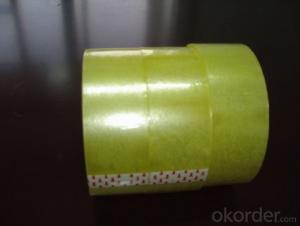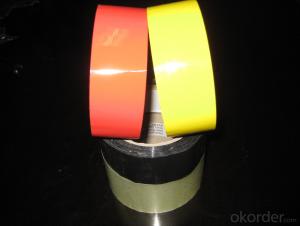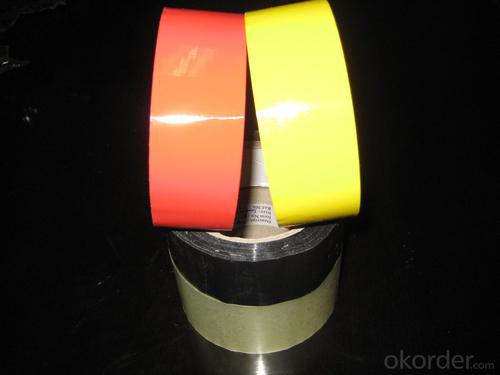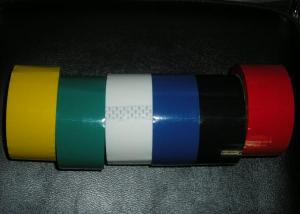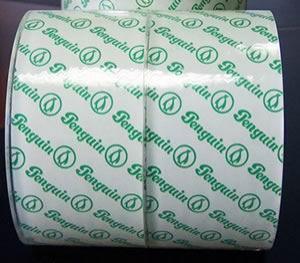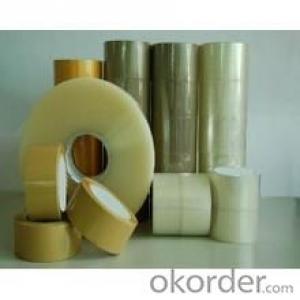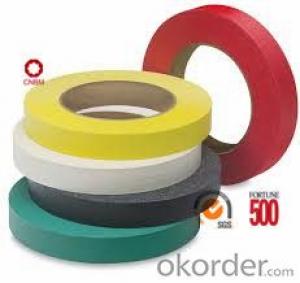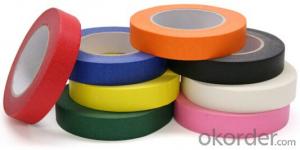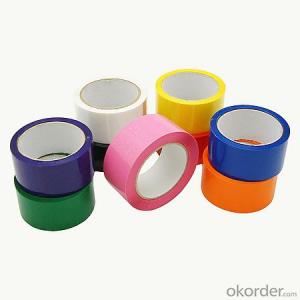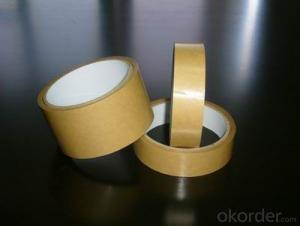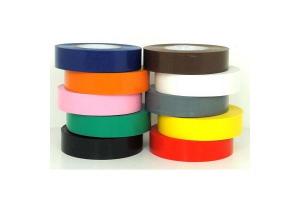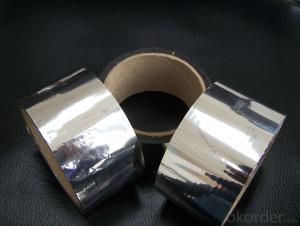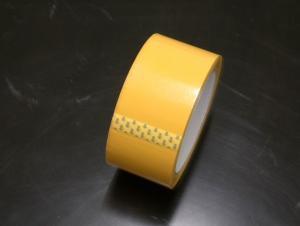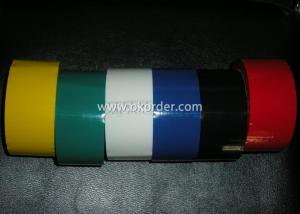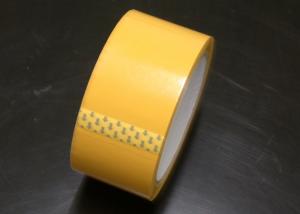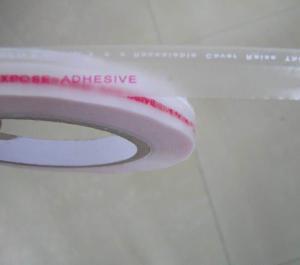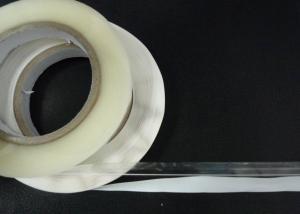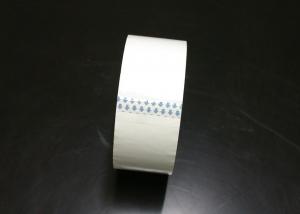IKEA Packaging Tape - High Performance 60 Micron
- Loading Port:
- China Main Port
- Payment Terms:
- TT OR LC
- Min Order Qty:
- -
- Supply Capability:
- -
OKorder Service Pledge
OKorder Financial Service
You Might Also Like
CONSTRUCTION:
Carrier: BOPP film
Adhesive: Water based acrylic adhesive.
TYPICAL PHYSICAL PROPERTIES:
Total Thickness (adhesives + carrier): 60± 2 um
Initial Tack (11mm steel ball): ³ 18#
180O Peel Adhesion (to steel): ³ 0.5 kgf /25mm
Holding Power: ³ 24 hrs
Tensile Strength: ³ 30 N/cm
Elongation: ≤180%
PACKING:
Core I.D.: 3” (76mm±1)
Jumbo Roll:1280mm x 4000m
Cut Roll: As per customer’s requirements
Application:
Carton sealing & packing, Light duty packaging, bundling, holding, and other office & household use.
REMARKS:
1. The data above are typical results and subject to change without notice.
2. Tolerance: Weight and Thickness: ±10%; Width: ±3mm;
Length: Cut Roll & Log Roll ±0.3m, Jumbo Roll ±0.5%.
3. The products should be stored at room temperature and be kept away wet and/or heat source.
4. It is essential, as with all pressure-sensitive tapes, that the surface to which the tape is applied must be clean, dry, and free of grease and oil.
5. The users should take test and do trial-application on the above products before coming into application so as to witness and ensure suitability for their special purpose and technique.
- Q: Is packaging tape safe to use on plastic picture frames?
- Yes, packaging tape is generally safe to use on plastic picture frames. Packaging tape is designed to be strong and durable, making it suitable for securing items, including plastic frames. However, it is important to consider a few factors before using packaging tape on plastic picture frames. Firstly, ensure that the tape does not have any adhesive that could potentially damage or leave residue on the frame. It is advisable to test a small, inconspicuous area of the frame with the tape before applying it to the entire frame. Additionally, when removing the tape, do so carefully to avoid any potential damage to the frame. Overall, as long as you exercise caution and choose an appropriate tape, packaging tape should be safe to use on plastic picture frames.
- Q: What are the benefits of using UV-resistant packaging tape?
- UV-resistant packaging tape offers numerous advantages. Firstly, it is specifically designed to endure prolonged exposure to sunlight, preventing it from deteriorating or degrading. This is particularly crucial when shipping or storing items outdoors or in areas with direct sunlight. With UV-resistant tape, packages can remain securely sealed for extended periods as it maintains its adhesive properties and structural integrity. Furthermore, UV-resistant packaging tape safeguards the contents of packages from UV ray damage. Sunlight can cause materials like paper, fabrics, or plastics to fade, discolor, or degrade. By utilizing UV-resistant tape, these items are shielded from the harmful effects of UV rays, preserving their quality and appearance. Moreover, UV-resistant packaging tape boasts long-lasting adhesion. Unlike regular tape, which may lose its stickiness over time when exposed to sunlight, UV-resistant tape is specially formulated to bond tightly and securely to various surfaces. This reliable adhesion minimizes the risk of packages opening or items sustaining damage during transit. Additionally, UV-resistant packaging tape provides peace of mind for both senders and recipients. By opting for tape that is resistant to UV rays, businesses and individuals can ensure that their packages arrive in the same condition they were sent, enhancing their professional image and customer satisfaction. This advantage is particularly vital when shipping valuable or delicate items that require extra protection. In conclusion, UV-resistant packaging tape offers enhanced durability, protection against UV damage, long-lasting adhesion, and increased confidence in package integrity. By selecting UV-resistant tape, individuals and businesses can effectively safeguard their packages and their contents, even when exposed to prolonged sunlight.
- Q: Can packaging tape be used for other purposes besides packaging?
- Yes, packaging tape can definitely be used for other purposes besides packaging. Due to its strong adhesive properties and durability, it can be used for a variety of tasks. For example, it can be used for household repairs such as fixing a broken book spine or securing loose cables. Additionally, it can be used for crafting projects like creating temporary or permanent decorations, making durable envelopes, or even in DIY projects like creating makeshift labels or organizing items. Furthermore, packaging tape can also be used for temporary fixes, such as sealing small leaks or cracks in pipes or containers until a permanent solution is found. The versatility of packaging tape makes it a handy tool to have around the house or office for various purposes beyond just packaging.
- Q: Can packaging tape be used for bundling items together?
- Absolutely, packaging tape is perfect for bundling various items together. It serves as a reliable means to firmly secure and hold multiple objects, particularly when engaged in shipping or relocating. Engineered to possess strength and dependability, packaging tape ensures a steadfast grip that effectively keeps items tightly bundled. Frequently employed for the purpose of bundling boxes, packages, or any other items necessitating cohesion during transportation or storage.
- Q: How do I prevent packaging tape from unraveling?
- To prevent packaging tape from unraveling, you can try a few techniques. Firstly, make sure to choose a high-quality tape that is specifically designed for packaging. Secondly, before cutting the tape, apply a small piece of clear tape to the end of the roll to secure it. Additionally, store the tape in a cool and dry place to avoid heat or humidity causing it to unravel. Lastly, ensure that you apply the tape firmly and smoothly, avoiding any wrinkles or loose ends, which can lead to unraveling.
- Q: Can packaging tape be used for sealing packages with fragile artwork or sculptures?
- Indeed, one can utilize packaging tape for the purpose of sealing packages containing delicate artwork or sculptures. Nevertheless, it is crucial to exercise caution in selecting the appropriate variant of packaging tape to guarantee the safeguarding of the artwork. In general, it is highly recommended to opt for a top-notch, robust packaging tape that has been explicitly crafted for the purpose of shipping and handling fragile or delicate items. These varieties of tape often possess added reinforcement through the inclusion of fibers or augmented adhesive strength, thereby ensuring a secure seal and averting any potential harm during transportation. Furthermore, it is advisable to employ suitable cushioning materials such as bubble wrap or foam padding to provide adequate protection for the artwork housed within the package.
- Q: Are there any specific instructions for reusing packaging tape?
- Yes, there are a few specific instructions for reusing packaging tape. Firstly, ensure that the tape is still in good condition and is not torn or damaged. Gently peel off the tape from the package, being careful not to rip it. Next, find a clean surface to roll the tape onto, such as a smooth piece of cardboard or a tape dispenser. Avoid folding or crumpling the tape as it may lose its adhesive properties. Finally, when reusing the tape, make sure to press it firmly onto the new package to ensure proper adhesion.
- Q: What are the considerations for using packaging tape on plastic or polyethylene bags?
- When using packaging tape on plastic or polyethylene bags, there are several considerations to keep in mind. Firstly, it is important to select the right type of packaging tape that is suitable for use on plastic or polyethylene surfaces. Some tapes may not adhere well to these materials, resulting in poor adhesion and the tape easily peeling off. It is recommended to use tapes specifically designed for use on plastic or polyethylene surfaces, as they are usually made with adhesive formulas that can adhere properly to these materials. Another consideration is the strength and durability of the tape. Plastic bags can often be lightweight and flexible, so it is important to choose a tape that can provide enough strength and durability to secure the contents of the bag. Look for tapes that have a strong adhesive backing and are resistant to tearing or stretching. The temperature and environmental conditions should also be taken into account. Extreme temperatures can affect the adhesive properties of the tape, causing it to lose adhesion or become brittle. If the bags will be exposed to high or low temperatures, it is recommended to choose a tape that is specifically designed for those conditions. Additionally, it is crucial to ensure that the tape does not damage the plastic or polyethylene bags. Some tapes may have strong adhesives that can leave residue or cause damage when removed. Look for tapes that are designed to have low residue, easy removal, or are specifically labeled as safe for use on plastic or polyethylene surfaces. Lastly, consider the aesthetics and presentation. Packaging tape comes in various colors and designs, so you may want to choose a tape that complements the bag's appearance or branding. It is also important to ensure that the tape does not obstruct any important information or barcodes on the bag. In summary, the considerations for using packaging tape on plastic or polyethylene bags include selecting the right tape, ensuring strength and durability, considering temperature and environmental conditions, preventing damage to the bags, and considering aesthetics and presentation.
- Q: Does packaging tape have any specific certifications or standards?
- Yes, packaging tape can have specific certifications or standards. Some common certifications or standards for packaging tape include ISO 9001 (quality management), ISO 14001 (environmental management), and ASTM D1974 (standard specification for sealing and securing pressure-sensitive tape for packaging). Additionally, certain industries may have their own specific certifications or standards for packaging tape, such as food-safe certifications for packaging tape used in the food industry.
- Q: What are the different types of packaging tape available?
- There are several different types of packaging tape available, each designed for specific purposes and applications. Here are some common types: 1. Clear packaging tape: This is the most commonly used type of packaging tape. It is transparent and provides a strong adhesive bond for sealing boxes and packages. Clear tape is versatile and suitable for a wide range of applications. 2. Brown packaging tape: Also known as "brown tape" or "packing tape," this type of tape is made from brown or tan-colored material, usually reinforced with fiberglass. It offers excellent strength and durability for securing heavy or bulky packages. 3. Masking tape: While not specifically designed for packaging, masking tape can be used for light-duty sealing or labeling purposes. It is easily removable and leaves no residue, making it ideal for temporary applications. 4. Duct tape: Often recognized for its strength and versatility, duct tape is not primarily designed for packaging but can be used in certain situations. It has a strong adhesive bond and is known for its ability to stick to a wide range of surfaces, including uneven or rough ones. 5. Filament tape: This type of tape is reinforced with fiberglass filaments, providing exceptional strength and resistance. Filament tape is commonly used for bundling or reinforcing heavy or irregularly shaped items. 6. Double-sided tape: Unlike other types of packaging tape, double-sided tape has adhesive on both sides and is used for various applications, such as bonding two surfaces together or mounting objects. 7. Kraft paper tape: Made from a renewable resource, kraft paper tape is an eco-friendly alternative to plastic tapes. It is water-activated and requires moistening before application. Kraft paper tape provides a strong seal and is often used for sealing cartons or packages containing valuable or fragile items. 8. Colored packaging tape: This type of tape is available in various colors and is commonly used for color-coding packages, labeling, or adding aesthetic appeal to packages. These are just some of the different types of packaging tape available in the market. Each type has its own unique characteristics and is suitable for specific packaging needs. When choosing the appropriate tape, it is important to consider factors such as the weight and nature of the package, the environment it will be exposed to, and any specific requirements or regulations that may apply.
Send your message to us
IKEA Packaging Tape - High Performance 60 Micron
- Loading Port:
- China Main Port
- Payment Terms:
- TT OR LC
- Min Order Qty:
- -
- Supply Capability:
- -
OKorder Service Pledge
OKorder Financial Service
Similar products
Hot products
Hot Searches
